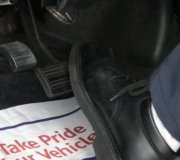You will not see anything loose. If you do find that, you will have had a real lot more noise for a long time. If you cannot find this with your ears under the hood, you might see a hint of black soot right where the exhaust is sneaking out. Most commonly this occurs at the very rear of the engine, especially on engines where the outlet is way to the rear. That is where the hot exhaust from all four cylinders exits.
Word of warning too; the bolt heads often round off if they are badly rusted. Use only six-point sockets for the best results. Use only a hand ratchet for now; no air tools. You want to feel the bolts creak and groan. That means they are protesting, but they are turning. If you feel a bolt twisting, stop and spray on some penetrating oil and let that sit for a while. If you do snap off a bolt, you will need to totally remove the manifold, then, if part of it is still there sticking out, you can try heating it orange-hot with an acetylene torch, then cooling it with cold water to shock it and break the threads loose. Use a vise-grip pliers to turn the bolt. Those will usually not grab the bolt well enough to allow you to snap it off again, but they will give you enough leverage to turn it once it comes loose.
If heat does not work, run to a Chrysler dealer's parts department and get a spray can of their Rust Penetrant. I am sure the other dealers will have something similar, but this is the one I am very familiar with. From experience with old cast iron TV antenna tripods, I know this stuff will do in ten minutes what WD-40 will not do in a weekend. I have heard good things about PB Blaster too, but I have only used that once or twice myself. Rust Penetrant was originally made for rusted heat-riser valves on the passenger side exhaust manifolds in the 1960's and 1970's. It goes on black and will sizzle, but do not leave it on any parts you will want to get apart in the future. Again, from experience, I found that when I sprayed it on tie rod end adjusters during an alignment, thinking it would be good preventive maintenance, when cars came back once a year for a regular alignment, I needed a torch to get those parts loose. Turns out it open the threads up and makes it easy for moisture to follow it in. On your manifold bolts, the oil will likely burn off quickly, but to be safe, wash it off with Brake Parts Cleaner or Carburetor Cleaner in a spray can to avoid future problems.
If you get a lot of rust crumbling off the bolt head, clean it first with a wire wheel or brush, then try to pound on a slightly smaller socket. In the worst case, you may be able to grind two or four flats on the solid part of the head, then use an open-end wrench on it. My biggest fear is breaking the bolt off flush with the cylinder head. That means drilling through the center of the stuck part, then using an "Easy Out". I have never had much luck with those tools. The center of the bolt is not hardened so it will drill pretty easily, but I have trouble keeping the drill bit in the center. If necessary, you can drill the hole larger and larger, then tap it and use a "Heli-coil" insert. The biggest problem is it seems these bolts always break where you cannot get a straight shot with a drill.
Once the hole is drilled large enough, tapping it and inserting the Heli-coil is fairly easy. I can describe that in more detail if necessary, or the person at the auto parts store can show you what to do. They should be able to determine the size you need, or take one of the non-broken bolts for them to look at. The basic kit comes with the correct drill bit, the correct tap, and usually two or three inserts with the little plastic tool to wind it in. These make a real effective repair. When you need to do a lot of these repairs, you can buy a box of inserts by themselves, without having to buy another drill bit and tap.
One more way of approaching this, if the head is real badly rusted, you might be better off to work on all the other bolts and get them out, then use an angle grinder to grind off the rusted head completely. If the steering shaft isn't in the way, slide the manifold off that bolt, then you will have much better access to work on it with the vise-grip pliers, and torch, if necessary. You might be pleasantly surprised to find the bolt really is not very tight. You just need a solid way to grab onto it.
Saturday, October 20th, 2018 AT 8:47 PM




